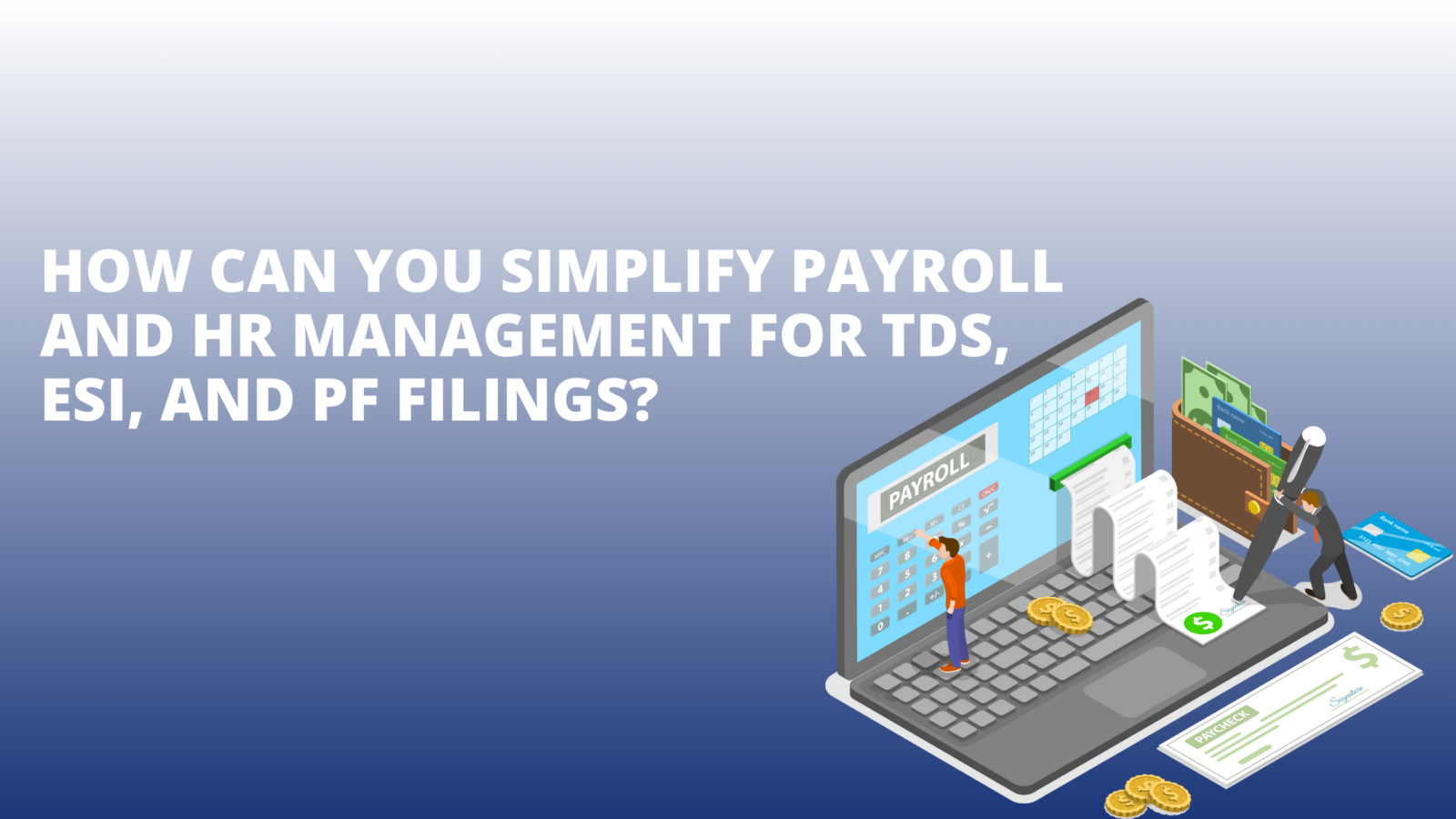Managing payroll and staying compliant is made simple. Running a business means handling many tasks. One big part of this is payroll and staying on top of compliance. This includes doing things like TDS filing, ESI returns, and PF contributions. These tasks can be hard. The laws are complex, rules keep changing, and deadlines are strict. Missing something can cause stress and penalties.
But here’s the good news: with the simple steps, you can make payroll and HR tasks much easier. In this blog, we’ll show you how to:
- Simplify your payroll process
- Stay on track with TDS filing, ESI returns, and PF contributions
- Save time and avoid mistakes
- Keep your business compliant and stress-free
Let’s break it down step by step.
What is payroll compliance, and why does it matter?
Payroll compliance means following the law when paying employees. It covers things like salary, taxes, and employee benefits.
In India, three important parts of payroll compliance are:
- TDS (Tax Deducted at Source) – money taken from salary and paid as tax
- ESI (Employees’ State Insurance) – a small cut from salary for health cover
- PF (Provident Fund) – savings for the employee’s future
If a business does not follow these rules, it can face big problems like:
- Paying penalties or fines
- Losing money
- Hurting the company’s name and trust
That’s why it’s important to manage TDS filing, ESI returns, and PF contributions carefully and on time.
Key Challenges:
- Evolving Regulations: The rules for TDS, ESI, and PF keep changing. New updates happen often. This means businesses must always stay alert and keep learning what’s new. If they miss a change, they may make a mistake.
- Complex Calculations: Doing TDS filing, ESI returns, and PF contributions isn’t just about simple math. It needs careful work. The rates are different for each employee, and sometimes they change. One small error can lead to a big problem later.
- Administrative Burden: Doing payroll and compliance work by hand takes a lot of time. It can be slow and tiring. Manual work often leads to mistakes, like wrong TDS filing or missing PF contributions. Fixing these mistakes takes even more time.
- Integration Issues: Many companies use different tools for HR and payroll management. But these tools don’t always work well together. This causes confusion, extra work, and delays. When systems don’t connect, things like ESI returns and leave records can be missed or done late.
A smart way to handle payroll and HR
Because of all these problems, businesses need better ways to manage payroll and HR tasks. They should use simple methods and tools that help with TDS filing, ESI returns, and PF contributions. This makes work easier, saves time, and keeps the business compliant with all the rules.
Simplifying Payroll Management for TDS Filing
TDS filing is a critical component of payroll compliance. Employers must deduct taxes at the applicable rates from employee salaries and deposit them with the government within prescribed timelines.
Key Steps to Simplify TDS Filing:
- Use Payroll Software: Choose a payroll software that has TDS calculation and filing features built in. This helps you do the math right and file on time. It saves time and lowers mistakes.
- Centralized Data Management: Keep all employee details, salary info, and tax-saving declarations in one place. This helps make sure your TDS deductions are correct every month.
- Periodic Reconciliation: Check your TDS deductions and TDS payments often. This helps find and fix any mistakes. It also helps you avoid fines and penalties.
- Stay Updated on Regulations: TDS rules can change. To stay on track, follow updates or get help from compliance experts. This way, you never miss a change in TDS rates or steps.
Example: A mid-sized IT company started using a new payroll management system. This system helped them do TDS filing the right way. In just one year, they made 25% fewer mistakes in their filings. This made their compliance better and saved a lot of time for the admin team.
When you automate TDS compliance, you get the tax amounts right every time. It also helps you file TDS on time. This means less stress for your team and fewer chances of non-compliance or penalties. It saves time and keeps your business safe from errors.
Streamlining ESI Returns
ESI is a social security scheme that gives medical and money benefits to workers. If a company has more than 10 employees (or 20 in some states) and their workers earn less than a set amount, the company must follow ESI regulations. This means they have to register and send ESI contributions on time.
Simplified ESI Compliance Strategies:
- Leverage Technology: Use payroll software that automates ESI contribution calculations and generates reports for returns filing.
- Ensure Accurate Employee Classification: Misclassifying employees can lead to incorrect contributions. Maintain updated records to avoid such issues.
- Online Filing: The Employees’ State Insurance Corporation (ESIC) portal allows for online returns filing, reducing paperwork and enhancing efficiency.
- Compliance Calendar: Maintain a compliance calendar to track due dates and ensure timely filings.
Example:
An FMCG company started using automation to handle its ESI returns. This helped them cut down manual work by 30%. They also reached 100% compliance, which means no missed steps or mistakes.
Using automated solutions and getting timely updates keeps ESI filings correct and on time. It reduces errors and helps businesses focus on what they do best.
Simplifying PF Contributions
Provident Fund(PF) contributions are mandatory for organizations employing 20 or more individuals. The Employees’ Provident Fund Organization (EPFO) requires employers to deduct and deposit contributions monthly.
Steps for Seamless PF Management:
- Adopt Digital Solutions: Payroll software with PF modules can calculate contributions, generate challans, and submit returns seamlessly.
- Employee Self-Service Portals: Enable employees to access their PF accounts, check balances, and download statements to reduce HR workload.
- Stay Compliant with Rules: Monitor changes in wage ceilings, contribution rates, and other EPFO guidelines.
- Outsource Compliance: Partner with HR management services specializing in PF compliance to reduce administrative overhead.
Example:
A manufacturing firm improved PF management
A manufacturing firm gave its PF management work to a team of experts outside the company. This is called outsourcing. It helped them make 20% fewer mistakes in PF contributions. Their HR team also got more time to focus on other important work.
By using digital tools and getting help from special service providers, businesses can make sure PF contributions are done on time and correctly. This also keeps employees happy and builds trust.
Integrated Payroll and HR Management Systems
Integrated payroll and HR management services play a vital role in simplifying compliance tasks for TDS, ESI, and PF filings. These systems consolidate payroll, employee records, compliance tracking, and reporting in a single platform.
Benefits of Integrated Systems:
- End-to-End Automation: Automates salary calculations, deductions, and compliance filings.
- Error Reduction: Reduces manual data entry errors, ensuring accurate compliance reports.
- Real-Time Updates: Provides instant updates on regulatory changes, ensuring continuous compliance.
- Data Security: Safeguards sensitive employee and payroll data with robust encryption protocols.
Example: A logistics company started using an integrated payroll system. This means their payroll and HR systems worked together. It helped them finish payroll processing 40% faster. It also made it easier to track TDS filings, ESI returns, and PF contributions, improving their compliance.
Challenges in Implementing Simplification Strategies
 While the benefits of simplified payroll and HR management are evident, businesses may face certain hurdles during implementation:
While the benefits of simplified payroll and HR management are evident, businesses may face certain hurdles during implementation:
- Initial Investment: Adopting advanced software or engaging external HR services requires upfront costs.
- Employee Training: Ensuring HR and payroll teams are proficient with new tools demands time and effort.
- System Integration: Integrating new tools with existing systems can be complex and time-consuming.
- Vendor Dependence: Over-reliance on external vendors may create challenges if service levels decline.
Key Considerations for Decision-Making
When choosing methods or tools to simplify payroll and HR management, consider the following factors:
- Scalability: Ensure the system or service can grow with your organization.
- Compliance Assurance: Opt for tools or services with a proven track record of compliance.
- Cost-Effectiveness: Evaluate the return on investment by comparing costs with time and error savings.
- User-Friendliness: Prioritize solutions with intuitive interfaces and comprehensive support.
- Customization: Choose tools that cater to your organization’s specific payroll and compliance needs.
Conclusion: Make payroll and HR simple with Finguruindia
Today, making payroll and HR management easy is not a choice—it’s a must. Every business needs to stay on track with TDS filing, ESI returns, and PF contributions. Using the right tools, automation, and connected systems helps you save time and follow all rules.
At Finguruindia, we help you handle this with ease. Our smart HR management services are made for your payroll compliance needs.
We can help you:
Automate TDS filings so you never miss a deadline
Simplify ESI returns to avoid mistakes.
Manage PF contributions without stress.
Let us take care of the hard work so you can focus on growing your business.
Read Our Article: The Ultimate Guide to Registering Your Business in India
Book a Consultation with Our Expert! 📞 Call Us: +91-9999127022 🌐 Visit: www.Finguruindia.com







